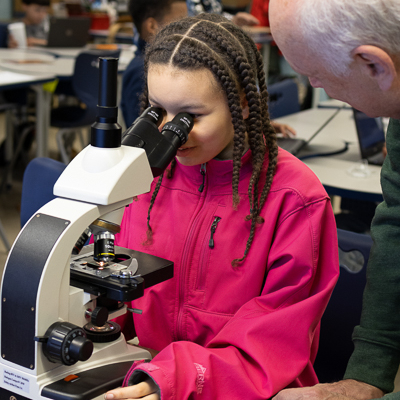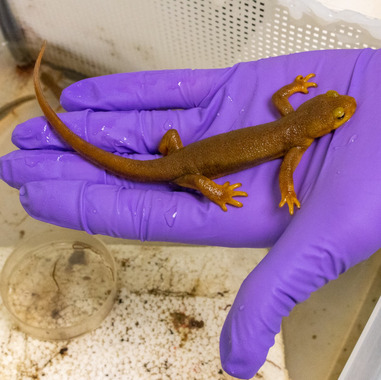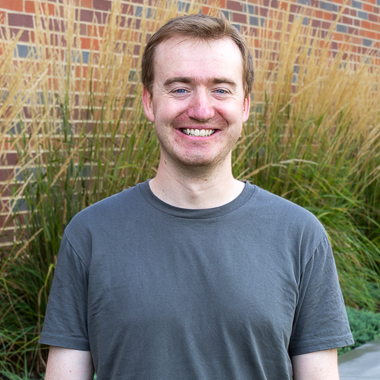Transgender scientists speak up about the challenges they face in academia and share how to support them
In a commentary published in the journal Cell, a group of 24 transgender (and/or family members of transgender) scientists describe what it’s like to be a transgender person in science, technology, engineering, mathematics and medicine, or STEMM.
One of the co-authors is Maeve McLaughlin. McLaughlin is a postdoctoral researcher in MSU’s Department of Microbiology, Genetics, & Immunology.
“I’m a trans-femme person,” McLaughlin said. “So ‘trans’ means that my gender is different from what I was assigned at birth, and ‘femme’ is just an indicator of being more femme-leaning than masculine-leaning, though I still consider myself to be sort of non-binary — sort of in this this weird space.”
 Maeve McLaughlin, Ph.D., co-authored a commentary
Maeve McLaughlin, Ph.D., co-authored a commentary
in Cell about life as a transgender scientist
McLaughlin was invited to participate in the commentary through her membership in a peer mentoring group for women and non-binary people in biomedical research. The group is called “Leading Edge” and was founded by Kara McKinley, an assistant professor at Harvard University.
“A lot of these folks in the Leading Edge program were people who were role models of mine as I was coming out,” McLaughlin said. “They were big names, they were trans people in STEMM, they were very active in social protests. And one of them was basically commissioned to write a piece for Cell about trans issues in academia. She asked several of us from Leading Edge if we wanted to be involved, and so that’s how I got my start in there.” In the commentary, the authors discuss the historical origins of trans marginalization, explain how this affects trans people’s careers in science and medicine and lay out actions that cisgender individuals and institutions can take to support trans people in STEMM.
This first-of-its-kind commentary appears in a sex and gender focus issue of Cell, covering topics such as gender equity, the history of sex and gender research, and how we can improve the quality of research going forward by using more rigorous and precise sex-related variables.
“I hope that trans scientists can see this piece as a beacon of hope,” says neuroscientist
and commentary author Dori Grijseels of the Max Planck Institute for Brain Research.
“It can be incredibly isolating to be a trans scientist, especially in particularly
hostile places, but I hope that this commentary can give a sense of community to those
scientists.”
McLaughlin echoes those sentiments. “Often, as a trans person, you live in spaces
where you might be the only person like you, and so even in a crowd of people it feels
very lonely.”
Currently, anti-trans legislation rooted in anti-scientific transphobic arguments enable these hostile and unwelcoming environments. “By standing up against this, scientists not only play an important role in trans liberation, but also scientific integrity and public trust in science,” says Grijseels.
The challenges trans people face inhibit their involvement in science and the advancement of their careers. “Legal and material precarity puts educational attainment and a productive research career, already a challenge for early career researchers, further out of reach for trans people,” write the authors.
Trans people are more likely to face harassment and discrimination in society and the workplace. They face more scrutiny to uphold what is considered “professional” dress and behavior.
“Any way a trans person dresses or acts is automatically taken as a statement that is highly scrutinized, in a way that a majoritarian cis male person won’t necessarily have to expect,” says evolutionary biologist and commentary author Jess F. McLaughlin (no relation to Maeve) of the University of Massachusetts Amherst. “It forces us to always be hypervigilant about our own presentation of ourselves in public, which is exhausting and very othering to deal with daily.”
“These expectations punish individuals who do not conform to a narrowly defined set of behaviors,” write the authors. “Controlling what is ‘acceptable’ gendered behavior or expression in the workplace marginalizes trans people, as well as cis people with nonconforming gender expression.”
“Appeals to professionalism have greater consequences for people with intersecting marginalized identities, such as for trans women of color, who face additional, uniquely racialized pressures to perform femininity.”
Finally, the authors outline what cis researchers can do to help their trans colleagues. “Individual actions can be distilled into three key components: showing respect to trans colleagues and students without singling them out, educating oneself and others, and utilizing one’s privilege and influence to advocate for institutional and political change,” write the authors.
“While it’s natural to feel hesitant about potentially making mistakes while trying to help, the risk of inaction — fueled by a fear of making mistakes — is far greater than the risk of attempting to make a positive change,” says neuroscientist and commentary author Evyn S. Dickinson of Yale University.
The burden of making these changes cannot fall solely on trans researchers. These changes will benefit the entire scientific community, write the authors. “Without sustained action by cis colleagues, achieving inclusion and equity becomes the de facto responsibility of those who are already burdened and marginalized.”
“When cis and trans people alike challenge sex and gender essentialism, we enshrine bodily autonomy and intellectual freedom. When we build institutions and systems to support all who contribute, we move to rectify scientific inequity and injustice.”



